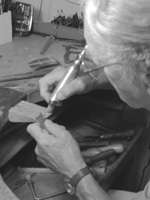George Brooks (jeweler)
George Brooks (born 1925) was one of the first designers and fabricators of modernist and wearable art jewelry in Canada, and later relocated to Santa Barbara in California.
George Brooks | |
|---|---|
 George Brooks at work, 1998. | |
| Born | George Rybnicek 1925 Brno, Czechoslovakia |
| Education | École des beaux-arts de Montréal |
| Known for | Jewelry design |
| Spouse(s) | Jean Brooks |
| Website | http://www.georgebrooksjewelry.com |
Early life and education
Born George Rybnicek in Brno, Czechoslovakia in 1925, Brooks immigrated with his mother and sisters to Montreal, Quebec, Canada in 1931.[1][2] His father was already living and working in Montreal as a tailor.[1]
After studying electrical engineering in college, Brooks chose to focus on visual arts.[1] He attended the École des beaux-arts de Montréal, where he studied sculpture and metalsmithing, and served apprenticeships with local jewelers before opening his own shop.[1][2]
Career




Brooks's first apprenticeship was as a goldsmith with Henry Birks and Sons in 1948.[1] He also set up a workshop at home where he could produce his own unique designs, markedly different to the conventional jewelry produced by Birks & Sons.[1] In 1950, he transferred his apprenticeship to Georges Delrue, a French avant-garde jeweler based in Montreal since 1947.[1] Delrue's work was influenced by European modernism, such as the work of Jean Arp, Joan Miró, and Jacques Lipchitz, and his workshop was the first modernist jewelry workshop in Canada.[1] Brooks worked with Delrue for seven years, where he learned from craftspeople such as the silversmith Hans Gehrig (1929-1989).[1]
Gehrig and Brooks went on to found the Montreal Gem and Mineral Club in 1957.[1] That same year, Brooks opened his first shop, which he sold in 1961.[1] Brooks and his wife Jean then travelled, visiting gem sources around the world, including mining for opals, in Andamooka, South Australia.[1] Brooks became a recognised authority on opals, amassing one of the world's largest collections of this gemstone.[1]
In 1962 Brooks relocated to Santa Barbara, California, where he continued working and producing unique, one-of-a-kind pieces of jewelry until his retirement in 1991.[2]
Exhibitions and Legacy
Yvonne J. Markowitz, Curator of Jewelry at the Museum of Fine Arts, Boston, co-wrote an essay on Brooks for a book on his work published in 2010, in which she argued that Brooks's work had been largely overlooked due to "an accident of geography."[1] In 1962, Santa Barbara was a small town which, although wealthy enough to enable Brooks to succeed enough that he had no need to publicise his work more widely, did not have the community to support modernist jewelers that existed elsewhere, such as San Francisco or Provincetown, Massachusetts.[1] She also noted that the "pioneering modernists" in Canadian jewelry design had worked in relative isolation, with few links to the American or European studio jewelry movement.[1]
In 2009, the Musée des maîtres et artisans du Québec held an exhibition on modernist art jewelry in Québec between 1950 and 1970, which showcased the work of Brooks alongside that of Delrue, Gehrig, and other Canadian jewelers.[3]
Jewelry by Brooks is represented in the collections of several museums and institutions, including the Renwick Gallery,[4] and the Museum of Fine Arts, Boston.[5]
References
- Markowitz, Yvonne J.; Ward, Susan (2010). "A Unique Perspective on Modernism". A modernist jewelry adventure. Santa Barbara: KRP Editions. The text of the essay is reproduced on Brook's official website: "A Unique Perspective on Modernism". George Brooks Jewelry. Archived from the original on 2014-11-01. Retrieved 8 January 2015.
- "Artist biography: George Brooks". Smithsonian American Art Museum. Smithsonian Institution. Retrieved 8 January 2015.
- "JEWELLERY AND ARTISTIC MODERNITY: the beginning of art jewellery in Québec (1950-1970)". Musée des maîtres et artisans du Québec. Archived from the original on 15 January 2015. Retrieved 8 January 2015.
- "Ring with Three Cultured Pearls, 1975, George Brooks". Search Collections. Smithsonian American Art Museum. Retrieved 8 January 2015.
- "Pendant necklace with turquoise cabochon, 1954. George Brooks". Collections Search, MFA. Museum of Fine Arts, Boston. Retrieved 8 January 2015.